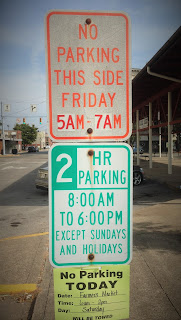It might be funny if not for the hair-tearing frustration of it. The same person who'll happily drive ten miles to walk back and forth across the Big Four Bridge will bitterly complain when "forced" to park two blocks from his favorite downtown restaurant.
Perhaps this is because the restaurant walk isn't as pleasing as the bridge walk, although it might be more pleasing if we weren't compelled to maintain downtown streets almost exclusively for cars, for the needs of cars as opposed to those of walkers, so as to ease our diner's transit from suburbia to the parking space just outside the front door of his destination -- you know, the one currently occupied by the business owner's personal car.
Obliquely, my favorite recent comment on this weird phenomenon comes from food writer Steve Coomes in a piece about the newly opened HopCat on Bardstown Road in Louisville. Is there enough parking?
HopCat will battle the same limited parking problem all its neighbors face. With just 23 spots on the lot, it’s expected diners will do as they do everywhere else: find a spot, any spot, park and walk to the restaurant.
I seem to have forgotten the point ... wait, yes; until New Albany's downtown parking garage is filled with cars every night, then the only parking problem we have is the inability of business owners and employees to park right there, in the parking garage. It's either cheap or free most of the time, and if the streets night are not sufficiently well lit or not pleasurable for walking, then by all means, please join me in making this point to City Hall.
But maybe if these parking spaces had value?
The opener ...
Parking meters and opportunity costs, by Daniel Hertz (City Observatory)
What if we could make parking spaces in high-demand areas more widely available, while also making better use of under-used parking spaces elsewhere?
Think of it as Uber’s “surge pricing,” but for parking. (Though it elicits some grumbles from a consumer perspective, we think surge pricing can make lots of sense: it encourages more efficient choices by riders, and brings out more drivers when they’re most in demand).
... and the closer.
But that’s not all that’s missing here. Proponents of “smart parking” say that one of their goals is to increase the usage of “underutilized” parking spaces. Often, that may mean increasing the total amount of driving. But, of course, driving incurs all sorts of extra social costs: pollution, wear and tear on public roads, injuries and deaths from crashes. When calibrating the appropriate price of parking on public space, should cities take those costs into account?










No comments:
Post a Comment